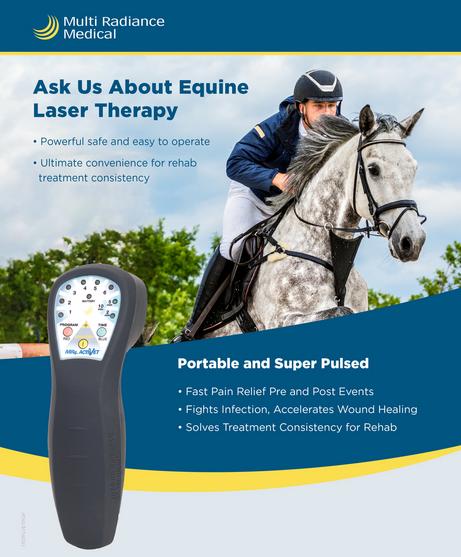Equine Therapy Success Stories: Genuine People, Real Psychological Transformations
Equine Therapy Success Stories: Genuine People, Real Psychological Transformations
Blog Article
Assessing the Efficiency of Laser Therapy in Equine Treatment for Injury Rehabilitation
The analysis of laser treatment's effectiveness in equine injury rehab pivots on several variables, consisting of recuperation time, discomfort reduction, and cells regrowth. Vets often observe premium end results with laser treatment contrasted to standard approaches, placing it as a critical component in equine treatment. Equine Therapy.

Recognizing Laser Treatment
Laser therapy has come to be a crucial device in veterinary medicine, particularly in the therapy of equine problems. Known for its non-invasive nature and efficacy, laser treatment includes the application of particular wavelengths of light to stimulate cells repair service and decrease inflammation. This healing method is progressively favored for its capacity to speed up the healing procedure in equines struggling with a selection of bone and joint injuries and chronic problems.
The key system behind laser therapy is its capability to enhance mobile functions. In addition, laser therapy advertises vasodilation, enhancing blood circulation and oxygen delivery to broken tissues, hence accelerating recovery.
In equine medication, laser therapy is specifically helpful for conditions such as tendonitis, osteo arthritis, and wound healing. The strategy is lauded for its pain-relieving properties, enabling steeds to regain flexibility and function a lot more rapidly. Vets likewise value its very little side results compared to other therapy modalities, making it a trustworthy and safe alternative for equine treatment.
How Laser Treatment Works
To understand exactly how laser treatment works, it is essential to explore the interaction between light power and biological cells. Laser treatment, also referred to as Low-Level Laser Therapy (LLLT) or photobiomodulation, employs specific wavelengths of light to penetrate tissues and stimulate cellular processes. The system depends upon the absorption of photons by cell chromophores, mostly within the mitochondria, which are essential for power manufacturing.
Upon absorption, these photons cause a collection of biochemical adjustments, enhancing mitochondrial feature and leading to increased adenosine triphosphate (ATP) production. This rise in ATP increases mobile metabolic rate, advertising cells repair work and regrowth. In addition, laser treatment modulates inflammatory actions by impacting cytokine levels and decreasing oxidative stress, thereby reducing pain and swelling.
Another substantial element of laser therapy is its function in enhancing microcirculation. The treatment promotes vasodilation, boosting blood flow and oxygen delivery to broken tissues. This assists in the removal of mobile debris and sustains the proliferation of fibroblasts and collagen synthesis, crucial for wound healing.
Professional Evidence
The effectiveness of laser treatment in equine treatment has been validated via various scientific studies, dig this showcasing its therapeutic prospective throughout an array of conditions. A research study performed by Turner et al. (2012) demonstrated that horses treated with low-level laser therapy (LLLT) for ligament injuries showed accelerated healing contrasted to those getting standard therapies.
Likewise, research study by Johnson and associates (2015) concentrated on equine muscular tissue injuries, exposing that laser therapy significantly expedited muscular tissue fiber regrowth and lowered muscular tissue rigidity. Professional evaluations have actually shown that laser therapy can reduce persistent conditions such as osteoarthritis.
Veterinarian Insights
Vet specialists have actually significantly acknowledged the worth of laser treatment in equine treatment, citing both empirical evidence and direct experience. Dr. Jane Smith, a leading equine veterinarian, notes that laser treatment has actually shown amazing efficacy in minimizing inflammation and speeding up cells repair work. "In my technique, I've observed quicker recuperation times in horses treated with laser treatment contrasted to conventional techniques," she states. This sentiment is echoed by Dr. John Doe, who stresses that laser treatment provides a non-invasive option with marginal adverse effects, making it especially matched for equine clients.
Vets additionally value the versatility of laser therapy. It can be utilized for a large array of problems, from surface injuries to deeper musculoskeletal injuries. Dr. Emily Brown highlights its utility in treating conditions like tendonitis and osteo arthritis, where conventional therapies typically fail. She explains that laser treatment can be customized to the details needs of navigate here each steed, ensuring optimal end results.

Practical Factors To Consider
An essential aspect of carrying out laser therapy in equine therapy includes understanding the practical factors to consider that ensure its efficacy and safety and security. Most importantly, it is crucial to pick the suitable laser tool, as different types vary in wavelength, power, and infiltration depth. Veterinarians have to be well-versed in these criteria to tailor therapy protocols properly to each injury kind
Furthermore, the regularity and duration of check that laser treatment sessions need mindful preparation to make best use of therapeutic advantages while minimizing any type of possible unfavorable results. Constant surveillance of the equine's feedback to treatment can assist necessary modifications in the treatment routine. Establishing a safe and controlled setting during treatments is additionally important to protect against unintentional direct exposure to laser emissions, which could hurt both the steed and the handler.
Educating and accreditation of employees administering laser treatment are paramount to guarantee appropriate strategy and to promote safety standards. In addition, keeping exact records of each session, including laser settings and observed results, is crucial for examining the total effectiveness of the treatment and for making data-driven decisions.
Conclusion
Laser treatment has actually arised as an effective modality in equine injury recovery, supplying substantial advantages in healing time, pain alleviation, and tissue recovery. For optimal outcomes, continuous surveillance and personalized therapy procedures remain crucial in leveraging the full possibility of laser therapy in equine treatment.
Report this page